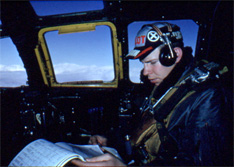|
Merle Hahn makes good use of his time by checking our aircraft records and making sure they are up to date. As is true of our other crewmembers, Merle’s performance on the ground and in the air provide indications of a potential for service that goes well beyond our current adventure of poking the Russian bear with a stick.
As I reflected on my own situation, I saw myself fulfilling a childhood dream of becoming a military pilot. Now, as the aircraft commander of an RB-29, preparing for a night run down the Russian coast, I began to get a glimmer that possibly that dream had become a reality. Although I worked my way through the Army Air Corps flying training program as an aviation cadet during WW II, training delays, elements of supply and demand in the pipeline, and other factors, prevented my grabbing the brass ring and being assigned a seat in a combat-ready aircraft.
During most of the Korean War, my assigned job was as a flight instructor in advanced twin engine training. My students were filling cockpits in the B-26s and B-29s that were supporting our beleaguered ground troops in Korea. My transfer to Randolph AFB, to be trained as a B-29 aircraft commander, was soon followed by a halt in the official fighting and the growing emphasis on what was becoming known as the “Cold War?”. Finally, with these flight crew members, these dear friends, we were being tested by real events. Our prayer was that we would be equal to the tasks before us.
The sun is getting low on the horizon. We are still churning toward the northwestern lip of Hokkaido. Over the open sea, with assurances from our crew radar resources that there was no ship traffic below, we had test fired each of the gun systems and found them all of good function. Sam Farley is now back in his tail gun compartment to serve as our rear view mirror (observer) and defender. Dick Sniker saddles up his position as the Central Fire Control Director, with his unique view of the top side of our operation.
We begin the process of turning out all exterior lights to reduce the chances of our being seen too quickly by any airborne visitors that may be searching us out. If the autopilot is functioning properly, we are glad for the assistance which leaves both pilots available to share in the visual searches for undesired company, keeping track of our operating conditions and safety, and working with crew coordination and communication.
After we had made our left turn toward the Russian coast, Our navigator, Fred, always had lots of encouragement and advice from the rest of the crew that it must soon be time for that next left turn down the coast. True to his calling, Fred had confidence in his position and invariably waited until just the right moment to make our turn. We trust the Russian radar observers were as relieved as we when they saw that sharp left, identifying this truly as a milk-run “Yoke” mission, not a penetration attempt.
As the depth of winter set in, the air and water temperatures we were dealing with were truly life-threatening without the protection offered by our RB-29. I can recall times when the inside of the cockpit was literally covered with a layer of frost, restricting our vision to the outer world during part of the mission. At these times, the extended wear of our rubberized survival suits was, in some ways, a comfort; but, in many ways, a great discomfort. It might be compared to a jeweler repairing a watch with a mitten on each hand.
I recall one tension-filled trip down the Russian coast when we identified the exhaust of one of their fighters gradually moving in on us and seemingly choosing to fly formation with us. It was some experience, trying to read the fighter pilot’s mind and be prepared for any aggression he might choose to use against us. He was obviously radar guided from his ground station. As aircraft commander, I was developing plans a, b and c, as it related to evasive action we would use if he opened fire. Thank God it never became necessary for us. In subsequent “Yoke” missions, we were more frequently finding possible fighter exhausts among the flickering stars.
The call for the next and final left turn, away from the Russian coast, was always a welcome announcement by our trusty navigator. Depending upon the timing of the flight and the time of the year, there were times when we arrived back over Yokota in the dark, early dawn, or full daylight. The governing criteria was always we had to have departed the Russian coast before daylight.
|

Merle does some bookwork
|